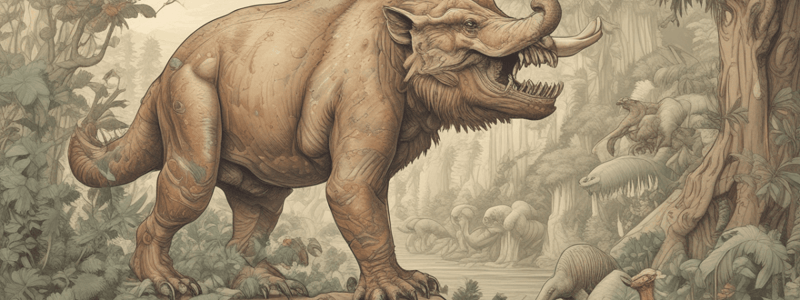Podcast
Questions and Answers
What is the primary mechanism by which individuals with favorable traits are more likely to survive and reproduce?
What is the primary mechanism by which individuals with favorable traits are more likely to survive and reproduce?
- Artificial Selection
- Natural Selection (correct)
- Mutation
- Genetic Drift
What is the term for the similar body parts in different species that have a common ancestor?
What is the term for the similar body parts in different species that have a common ancestor?
- Vestigial Structures
- Adaptation
- Species
- Homologous Structures (correct)
What is the term for the movement of genes from one population to another?
What is the term for the movement of genes from one population to another?
- Genetic Drift
- Natural Selection
- Mutation
- Gene Flow (correct)
What is the term for the study of DNA and proteins that shows the similarities and differences between species?
What is the term for the study of DNA and proteins that shows the similarities and differences between species?
What is the term for the process by which a species becomes better suited to its environment?
What is the term for the process by which a species becomes better suited to its environment?
What is the term for the random change in the frequency of a gene or genetic trait in a population over time?
What is the term for the random change in the frequency of a gene or genetic trait in a population over time?
What is the term for the organs or features that have lost their original function through evolution?
What is the term for the organs or features that have lost their original function through evolution?
What is the term for the chronological record of fossils found in rock layers, which shows the gradual changes in life forms over time?
What is the term for the chronological record of fossils found in rock layers, which shows the gradual changes in life forms over time?
Flashcards are hidden until you start studying
Study Notes
Evolution
Overview
- Evolution is the scientifically supported theory that all species of life have developed from a common ancestor through the process of natural selection, genetic drift, mutation, and gene flow.
- It is a gradual and ongoing process that has shaped the diversity of life on Earth over millions of years.
Key Concepts
- Natural Selection: the process by which individuals with favorable traits are more likely to survive and reproduce, passing those traits to their offspring.
- Species: a group of organisms that can interbreed and produce fertile offspring.
- Adaptation: the process by which a species becomes better suited to its environment.
- Homologous Structures: similar body parts in different species that have a common ancestor, such as the forelimbs of vertebrates.
- Vestigial Structures: organs or features that have lost their original function through evolution, such as the appendix in humans.
Mechanisms of Evolution
- Mutation: a change in the DNA sequence of an individual, which can result in new traits.
- Gene Flow: the movement of genes from one population to another, which can lead to the exchange of genetic information.
- Genetic Drift: the random change in the frequency of a gene or genetic trait in a population over time.
- Artificial Selection: the intentional selection of individuals with desired traits by humans, such as in agriculture and animal breeding.
Evidence for Evolution
- Fossil Record: the chronological record of fossils found in rock layers, which shows the gradual changes in life forms over time.
- Comparative Anatomy: the study of similar structures in different species, which reveals their common ancestry.
- Molecular Biology: the study of DNA and proteins, which shows the similarities and differences between species.
- Biogeography: the study of the geographic distribution of species, which shows how they are related to each other and their environments.
Theories of Evolution
- Darwin's Theory of Evolution: the original theory proposed by Charles Darwin, which emphasized natural selection as the primary mechanism of evolution.
- Modern Synthesis: the current understanding of evolution, which incorporates genetics, molecular biology, and other fields to provide a more comprehensive explanation of the process.
Evolution
Overview
- Evolution is the scientifically supported theory that all species of life have developed from a common ancestor through various processes.
- It's a gradual and ongoing process that has shaped the diversity of life on Earth over millions of years.
Key Concepts
- Natural Selection: a process where individuals with favorable traits are more likely to survive and reproduce, passing those traits to their offspring.
- Species: a group of organisms that can interbreed and produce fertile offspring.
- Adaptation: the process by which a species becomes better suited to its environment.
- Homologous Structures: similar body parts in different species that have a common ancestor, such as the forelimbs of vertebrates.
- Vestigial Structures: organs or features that have lost their original function through evolution, such as the appendix in humans.
Mechanisms of Evolution
- Mutation: a change in the DNA sequence of an individual, which can result in new traits.
- Gene Flow: the movement of genes from one population to another, leading to the exchange of genetic information.
- Genetic Drift: the random change in the frequency of a gene or genetic trait in a population over time.
- Artificial Selection: the intentional selection of individuals with desired traits by humans, such as in agriculture and animal breeding.
Evidence for Evolution
- Fossil Record: a chronological record of fossils found in rock layers, showing the gradual changes in life forms over time.
- Comparative Anatomy: the study of similar structures in different species, revealing their common ancestry.
- Molecular Biology: the study of DNA and proteins, showing the similarities and differences between species.
- Biogeography: the study of the geographic distribution of species, showing how they are related to each other and their environments.
Theories of Evolution
- Darwin's Theory of Evolution: the original theory proposed by Charles Darwin, emphasizing natural selection as the primary mechanism of evolution.
- Modern Synthesis: the current understanding of evolution, incorporating genetics, molecular biology, and other fields to provide a more comprehensive explanation of the process.
Studying That Suits You
Use AI to generate personalized quizzes and flashcards to suit your learning preferences.




